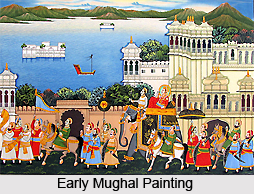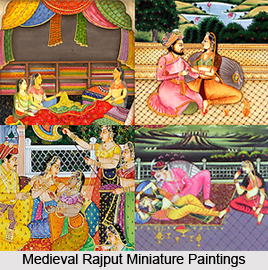 Babur, the first emperor of Mughals used to identify him with the Timurid family tradition and this family was ardently devoted to the arts of the book.
Babur, the first emperor of Mughals used to identify him with the Timurid family tradition and this family was ardently devoted to the arts of the book.
The paintings of early period of Mughals can be seen in a specialist organisation of a palace studio or scriptorium, which was managed then by Baysunqur. This scriptorium was headed by the legendary painter Bihzad of Mughal period. But unfortunately, the scriptorium broke up at the end of Husayn Bayqara`s reign and Bihzad was brought to Tabriz by the Saiavid Shah Ismail to organise the palace studio there. Some other painters were taken to Bukhara by the Uzbek conqueror, Muhammad Shaybani. But the fame of this scriptorium was not spoiled and it served as a model for the later built scriptoria by Humayun and Akbar.
The Mughal emperor, Babur himself was an expert of painting and inherited the taste of his Timurid predecessors. He had to abandon his entire baggage sometimes to include a whole library of illustrated books having paintings. Babur had never a stable residence, which was needed for keeping those expensive illustrated paintings, as those were very expensive. But when became the ruler of Samarkand, he became able to stock them properly.
Both Babur and Akbar were intensely attached with painting and Akbar`s great-grandson Jahangir was popular for his naturalistic representation and also for natural history. The Persian painting in drawings and studies in albums made for the Timurid rulers of Herat and the Turcoman rulers of Shiraz and Tabriz reflect their interest in naturalism. Their interest in naturalism was been motivated by Chinese drawings, paintings and textiles. This inclination towards naturalism brought a gradual revolution in the attitude of Muslim authors to painting as such.
There is a common belief that Islam proscribes figural art but an attitude of conditional tolerance towards figural representation was illuminated in few South Asian Muslim paintings. In the mid-sixteenth-century, a writer of Saiavid court librarian Dust Muhammad and the Qaji (Judge) Ahmad was inspired by Babur`s style of painting. He therefore wrote a treatise on painting saying life-like things should be the criteria of the paintings. Babur`s interest in natural history, with which his memoirs are instilled, was even more original.
One of the accounts of Mughals unfurls the fact that Babur was immensely inclined towards painting. Babur`s inclination towards natural painting can be imagined from few of his lines uttered when he was approaching a sheet of water near Kabul.
 He said, "we saw a wonderful thing something as red as the rose of the dawn kept showing and vanishing between the sky and the water... When we got quite close we learned that the cause was flocks of geese, geese innumerable which, when the mass of birds flapped their wings in flight, sometimes showed red feathers, sometimes not".
He said, "we saw a wonderful thing something as red as the rose of the dawn kept showing and vanishing between the sky and the water... When we got quite close we learned that the cause was flocks of geese, geese innumerable which, when the mass of birds flapped their wings in flight, sometimes showed red feathers, sometimes not".
According to the history, Humayun was not a worthy successor of rich Mughal painting. It is said so because in the early 1540s the Saiavid Shah Tahmasp, whose painting studio in Tabriz was the finest and the most highly specialized in the Islamic world, doubted the authenticity of commissioning so many beautifully illustrated manuscripts, at least to the extent of releasing from his service some of the finest painters of his studio. But Humayun`s stay in Persia was good for the history of Mughal painting. During his visit he brought Mir Sayyid Ali and abd al-Samada reputed calligrapher) to India and they established the Imperial Mughal painting studio. He continued to keep these painters even when he was still in exile and it was a considerable investment for the future painting. Mir Sayyid All is said to have implemented a scene from a polo match on a gram of rice, with goal posts at each end and horsemen, two in the centre of the field, one galloping in from a corner and a fourth being handed a polo stick by an attendant. He had drawn some of his figure paintings in unfavourable conditions.
The calligraphic skill of Abd al-Samad was displayed in the last chapter of the Koran, the Siirat al-Ikhlas. In that particular art work, he wrote on one side of a grain of rice, with a commentary to it on the other. Another Mughal painter of that time called Mulla Fakhr was praised for his skill in drilling poppy seeds with minute holes. But, there was hardly anyone in Humayun`s court, who was able to look for the details of such a wonderful art work. The portraits of painters in Mughal and Saiavid art show them wearing spectacles quite frequently and the best work of these painters were done mainly at there early young age. This is probably due to these miniature paintings done by them.
Tamerlane was a famous painter of Babur`s period, whose successor at Herat and Samarkand and the Saiavids painted various miniature paintings in the public rooms of the Mughals emperors. Tamerlane himself is said by later historians to have ordered illustrations of his victories and feasts in various palaces built for him at Samarkand. One more painter called Shah Tahmasp was even reported to have decorated the Chihil Sutun palace at Qazvin himself, with scenes including the appearance of Joseph before Potiphar`s wife (Zulaykha). His personal initiative might have been flatteringly exaggerated and he might not even have sketched the sort of thing he wanted but he merely specified it in detail.
Akbar got decorated the walls of his private apartments at Fatehpur sikri by the painters of his studio, but these have very little traces to have a proper idea of them. Most of these paintings were small in scale and not monumental. The British Museum now contains the paintings of various later Mughal figures, including Akbar, Jahangir and Prince Khurram (who ruled as Shah Jahan). In these paintings, the central figure is labelled as Tamerlane and is often said to be Humayun. But, there is no authenticity of the persons in these paintings. If it was the genealogical scene of the Mughals then Babur must be the centre figure of the painting. The landscape and figures are very much in the style of court painting at Tabriz in the early 1540s and looked so different from any Mughal painting of the later sixteenth century.



















